What a fun topic! No, I mean that sincerely, I find this an interesting intellectual exercise since it is kind of like looking at my culture through a looking glass.
Non-Usual Disclaimer: I am not Indian, and I am not Black, so my only justification for writing this post is that I am a human trying to be human. If I make a mistake because of blindness to my own privilege, tell me.
America did not invent racism. I don’t mean prejudice and othering and so on, I mean actual racism, judging groups based on skin color and other physical characteristics. It’s a strange form of American exceptionalism to think that we did. Every culture in the world has it’s own unique and ugly version of racism.
South Asia has such a variety of racism, far too much for any one person to understand, especially someone like me who is an outsider. I struggle to even keep track of ethnic prejudice versus caste prejudice versus class prejudice, and then racism adds in a whole other puzzling layer. I know there is so much I am just not seeing, probably even unknowingly learning and repeating. All I can be sure of is that I have made the first step, an awareness that there is racism in South Asia and it is unique to South Asia, not a result of outside influence.
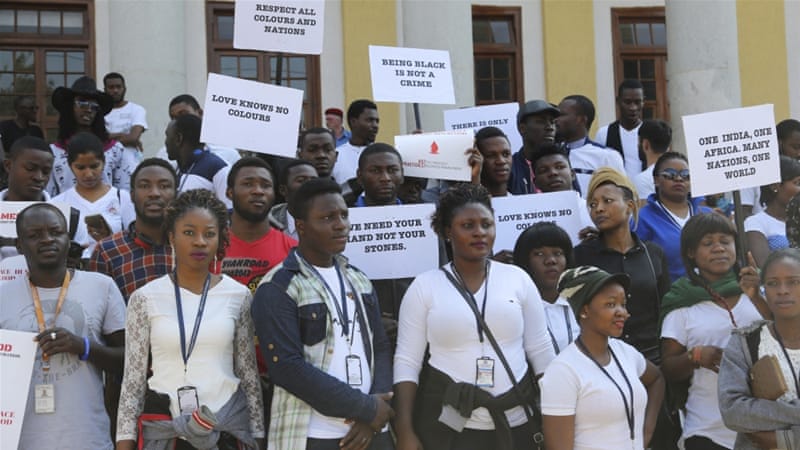
The South Asian racism I learned first is the one that is similar too but different from American racism, prejudice towards people with darker skin and kinkier hair. There’s a whole variety of groups this effects. There’s the African immigrants who came to India for work, there’s the Adivasi communities of hunter-gatherers, there’s the lower caste communities in certain areas, and there’s the general northern prejudice towards the south. This is not racism that was invented by American pop culture, or even by British colonialism. It was already there. People with those physical characteristics are seen as less “civilized”. And also of course ugly and undesirable.
The most visible form of this racism is the “Fairness Cream” campaigns. People want fairer skin because they don’t want to be associated with the communities seen as being darker skinned. Less visible is the “hot oil” hair treatment part of it. You don’t want curly hair either, you want fair skin and straight hair. But both of those are usually seen through the lens of people from the “good” races who don’t want to be mistaken for being from the “bad” races. Hidden behind it are the people who aren’t buying fairness creams or getting hair treatments, they are not passing as something else, they are living lives of oppression and misery because of their race.
When I am watching a Hindi film, I am trying very hard to see through my white blinders and find the racism. As I try every moment of my life, and I am sure my fellow white people on DCIB do the same. Part of white privilege is the ability to simply not see racism, you have to put in the work to see it. But at some point I realized I have to see through two blinders when watching Indian film, I need to see the racism, and I also need to see my own cultural superiority. The racism I see is not necessarily my racism, it can be someone else’s.
For example, I truly do not think the racism in Bahubali as shown in the Kalakeya characters is American racism. I think it is Indian racism. The Kalakeya’s are a version of the Adivasi, with a little bit of fear of the Nigerian immigration. They use wood and stone instead of metal, they wear animal skins instead of woven cloth, their warfare methods are hand to hand instead of using advanced tools, and they do not plan ahead or negotiate, they are overwhelming through numbers. It’s a metaphor, the battle between civilization and higher reasoning versus pure passion. A racist metaphor, yes, but still a metaphor. That metaphor only works through the Indian version of racism, not the American version. To look at the Kalakeya and see American racism is another form of blinders, assuming that all cultures are merely reflecting your own.

And now I am going to contradict myself and say that sometimes the racism in Indian film is American racism. As many other people have pointed out, racism is one of America’s biggest export. As our popular culture products go out into the world, so does the racist version of America they represent go out into the world. One of the biggest indications for me that an Indian film is using American racism, not Indian racism, is when it is in America. The version of America they see has racism built into it.
A couple of months ago at my office, we were talking about the overly sensitive security alarms at the local pharmacy, and how all of us (three young white women and one young Japanese heritage woman) have been caught by them. My Indian co-worker was surprised to hear the store security had bothered to stop us, because of course shoplifters are black men, not young non-Black women. The rest of us, American raised, were surprised and said no, of course that is not true, most shoplifters are non-Black woman. I mean, that’s just a fact. To the point that even stores know it, shoplifting is the only crime I have ever been profiled for (not that I am complaining or anything, just pointing out how well known it is that young white woman loitering in make-up aisles are likely to steal). This is an educated woman, liberal, intelligent, and so on and so forth. But racism in America is so insidious, so pervasive, that she blindly believed something without understanding it was racism.
The teacher of my Indian American sociology class in college said that learning racism is part of assimilation as an American. I am reminded over and over again how true that is when watching Indian films. It’s not an excuse, racism is never forgivable, but it is yet another aspect of cultural blindness I need to watch for. Often racism in Indian film is so incredibly blatant and unacceptable that I assume it must be a mistake, or so on the nose that I assume it is on purpose, and that’s not necessarily true.
For example, in Jaan-E-Mann (one of my favorite movies), Salman Khan gets his child’s overweight African-American nanny out of the apartment by putting a pizza outside the door. And then he routinely starts sneaking into the apartment because he doesn’t trust the nanny to be reliable. The nanny is shown to be lazy, irresponsible, impulsive, on top of also being overweight and a household worker. It’s a throwback to a Gone With the Wind kind of racism, the funny useless “mammy” type. This isn’t modern American racism really, so when I first watched the film I thought maybe it wasn’t racism at all. That maybe it was a spoof of racism, or maybe it was just a coincidence. But American culture doesn’t export racism in a tidy historically layered way, the racism that pops up in other cultures can be from any point in our history. The Indian filmmakers thought “American childcare worker” and their minds went to the “mammy” stereotype without any further thought.

On the other hand, in Sultan, at one point the fighters in the mixed martial arts contest are introduced by their names and then the names of their sponsors referred to as their “owners”. Two of the fighters are dark skinned and the use of “owner” terminology falls harshly on American ears as it echoes slavery. But that same terminology is used for all the fighters, dark skinned, central Asian descent, and our south Asian hero. I think hearing “owner” and thinking “racism” is a sign of American centralism in this case. That terminology is not the kind of thing that we export in our popular culture products, it’s not a stereotype or a prejudice, it’s a very specific type of word taboo referring to a very specific historical reality of our country.
Let’s talk about stereotypes versus history. Stereotypes are something you learn without effort, history you have to work at. The people in power in American society use stereotypes, and if you want to be part of their group, you start using the same stereotypes language they do. Black men are dangerous, muggers, rapists, they will attack you. Black woman are unattractive and dumb, or (occasionally) overly sexual in a way that you are a big ashamed to be attracted to them (I have seen multiple Indian films that include “sexy” dark skinned maids as part of the background of a rich NRI household). But to know the history of American slavery, over-incarceration, structural racism, and so on and so forth, that requires work. The price of that is leaving the comfortable bubble of the powerful folks, to see the evil that your new “friends” are doing. It’s not fun or easy or something anyone wants to do.
An Indian film set in America wants to feel “American”. So the filmmakers talk to the people they know who are American and get an impression of the country, and the impression they get is the one that belongs to those in power. A mugger in an American set Indian film will be a Black man. A professional person in an American set Indian film (lawyer, businessman, doctor) will be white. This is American racism in India, the racism we are teaching to outsiders. It is the fault of the multigeneration white Americans in power, yes. I take responsibility for it on a macro and a micro level, I have benefited over and over again my entire life from racism and there have been times I have not confronted it around me.
But there is a responsibility of the people from outside the culture who are learning this racism as well. Karan Johar should have done more researched, read more books, learned more before he tried to include an African-American community in My Name is Khan. And I am pleased that the mugger in Ra.One was white, that was not a coincidence and it was a moment of living up to their responsibility.
In response to the #BlackLivesMatter movement, a fair number of desis are posting hashtags on twitter and trumpeting their virtue. It is a surface sign of anti-racism, but it doesn’t really make sense for American racism through an Indian lens. #BlackLivesMatter is about Black people being killed and no one caring. That starts with someone thoughtlessly believing most criminals are Black, that Black men are more dangerous than White men, with showing a world in which those in desirable positions are white and not questioning why that might be. You can’t say #BlackLivesMatter without understanding why that phrase itself matters.
Alaya Furniturewalla, surprisingly, put up the best post I have seen in the particular Indian celebrity corner of social media. She does not look outward, she looks inward, at herself and at Indian culture. The post is directed towards those around her, her fellow privileged global Indian celebrities and the global Indian elite who read tweets from those celebrities. I am not one of those people, but this post gave me a glimpse of a closed world and the groupthinking of that world. I was shocked.
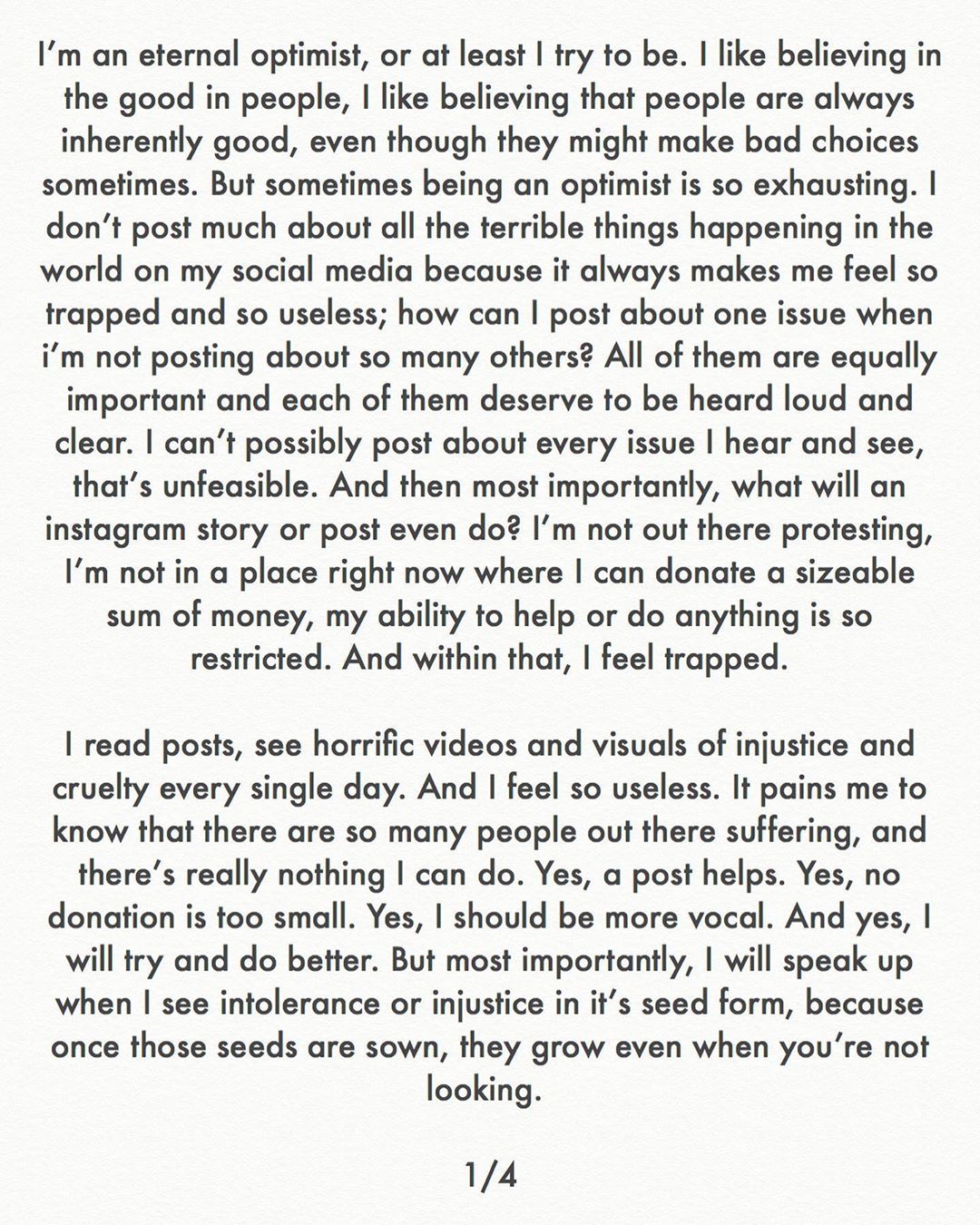
Alaya starts by calling out people for using the N word in conversation while tweeting “#BlackLivesMatter”, and calling out herself for not confronting her friends more aggressively when they use that word. I am stunned by this revelation. Alaya is talking about young highly educated global desis. I had no idea this community was using the n-word. The white equivalent, urban highly educated young people, would consider that word completely forbidden. At the very least, they would know they were breaking the rules and doing something unusual when they said it. Alaya is revealing to me that her generation is not learning racism of her generation, but rather of previous generations, they are not just as bad as their fellow Americans, but far worse than their fellow Americans in a similar position (age, education, urbanity, performing liberalism through hashtags, etc.).
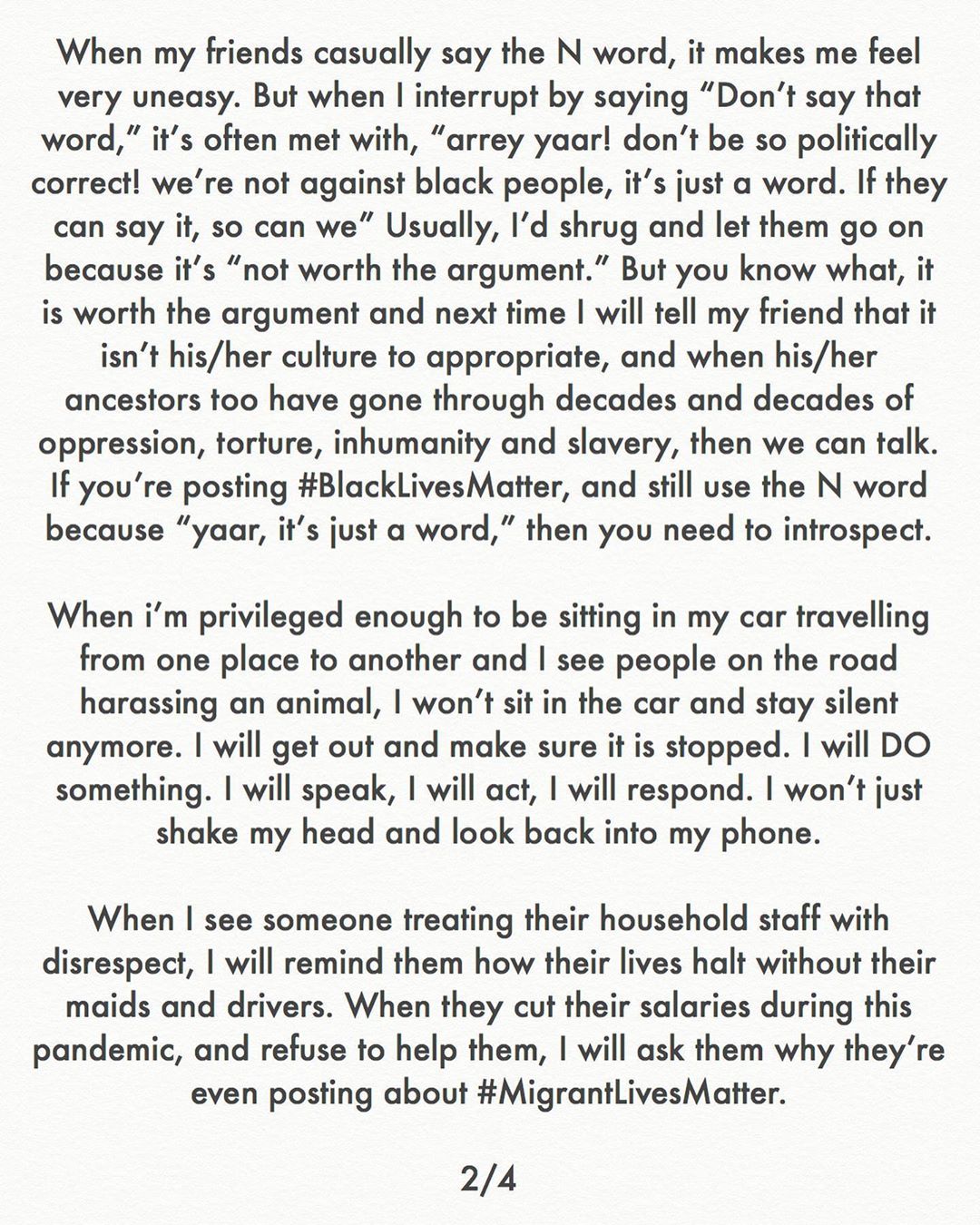
And then Alaya goes on to call out other hypocrisies she has committed, talking about animal rights but not stopping her car to object when she sees an animal being beaten, talking about Migrant worker rights while cutting the salaries of your household help during this time, talking about LGBTQIA+ rights while using f—-t (again, shocking to me that this completely forbidden word of an older generation is being used by a younger generation of desis), talking about woman’s safety while being scared to use the word feminism. These are all excellent points, and specific to the privileged young global desis.
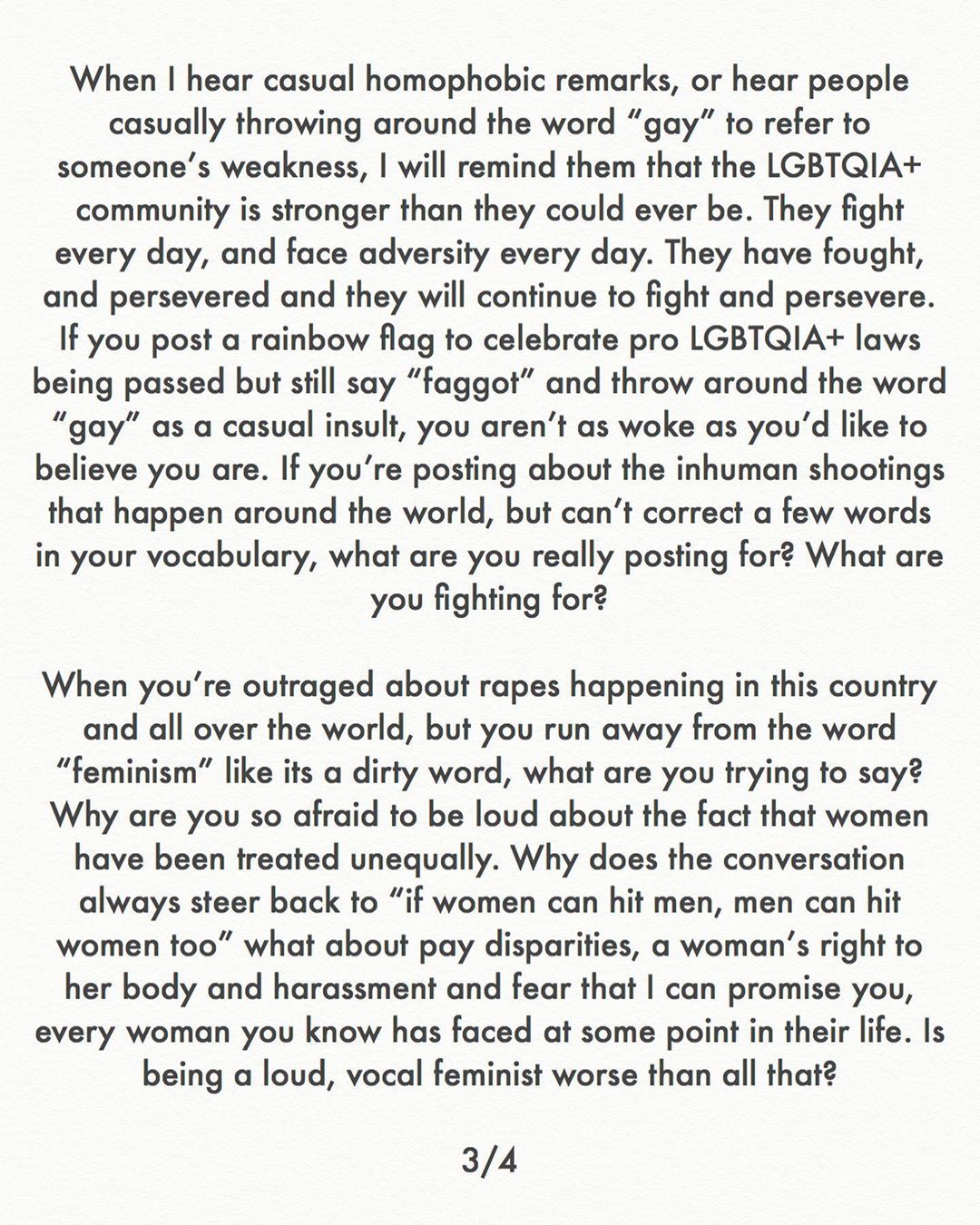
But look at the order of her points. Animal cruelty comes before migrant worker rights. And she spends more words on it. Not only that, her take on the issue is that she should stop her car and go defend the animal from those abusing it. The picture this paints for me is Alaya in her air conditioned car stepping out of it to educate the lower class poverty ridden people who are abusing their animal. There is a blind privilege of assuming she knows better and it is her right to educate them. There is the blind privilege of assuming she knows everything about the situation and what she sees as harassment is a choice and not a necessity (is that man beating an elephant for the joy of it, or because he needs the animal to help him labor to feed his family? Is Alaya going to provide a solution for his poverty or just tell him to stop hitting the animal?). And of course there is the blind privilege that, while riding her car through India, it is the ANIMALS she sees out the window that she thinks she has to save. I have ridden a car through India and, from an outsider’s perspective, I noticed the animals far far less than I noticed the children. Alaya is trying to do the right thing, trying to confront her assumptions, and even so she is revealing so much about her blindness.
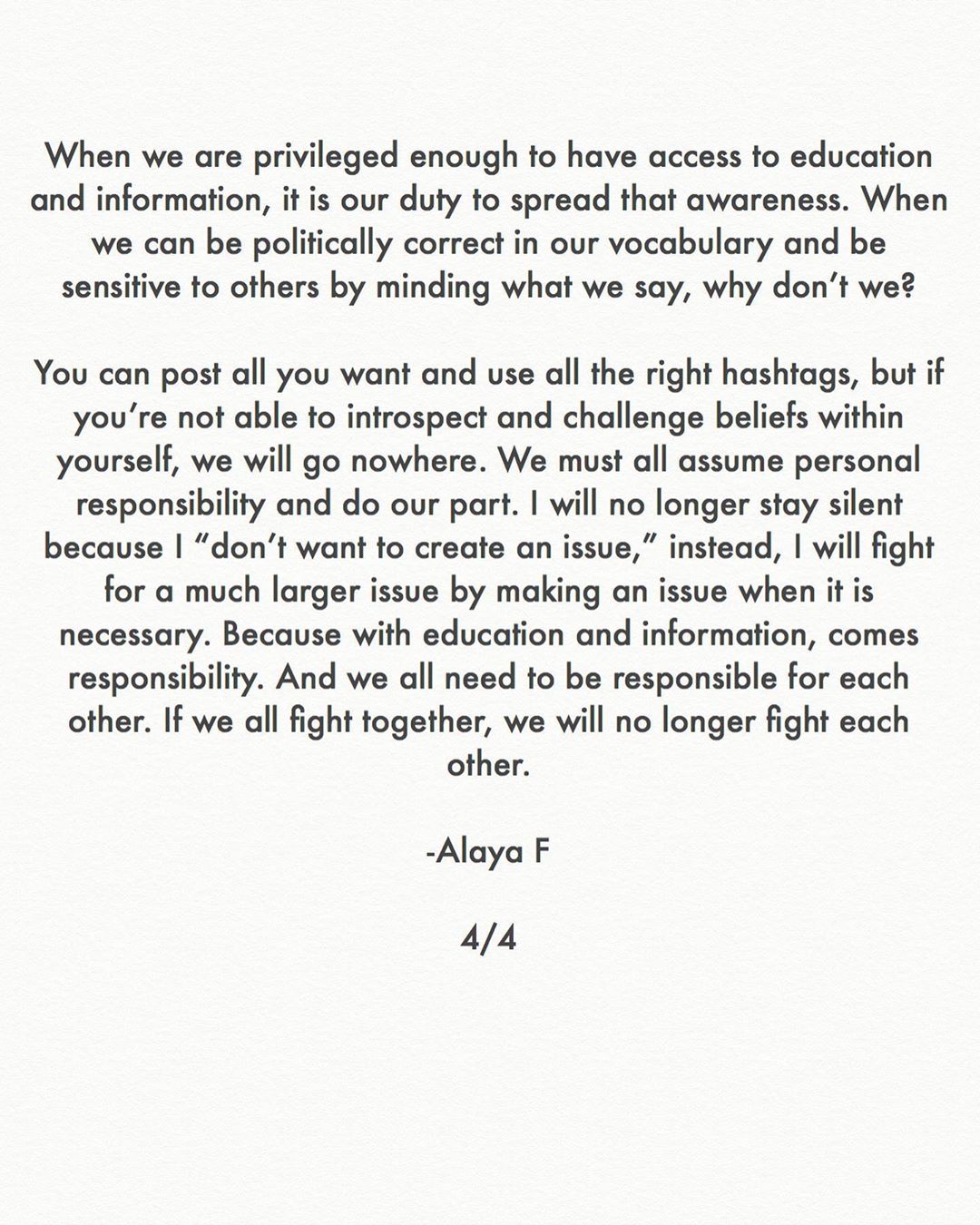
I am no better than Alaya, I have my own blindspots that I don’t know about, there is something in this very post that surely reveals it. What makes me hopeful in Alaya’s post is that she is so easily able to pick out the prejudices she learned from outside, the American racism and Western homophobia (“f____t” is not an Indian word), to see that they are a price she pays for an easy global life. Indian films, and Indian celebrity culture, can do so little work to make so much progress in removing American and Western evil from their thinking. They just have to identify it and reject it. It is possible, it is easily possible.


This is too heavy for me to talk about in any rational way. But I want to say how much I love that the African American woman is featured with the rest of the cast in the Kumbalangi Nights poster without fetishizing her or dehumanizing her. And her character’s role in the narrative was great too, she’s the first woman to move into the household and the youngest brother is thrilled by her being there because it’s the first sign that they are forming a true family and home.
LikeLike
Her sexuality is handled so well, is what I noticed in particular. She is in control of her sexuality, she won’t be rushed into marriage, nor will she be shamed for having sex outside of marriage. I’ve noticed a growing number of sexualized African-American (or British African) women in Indian films. In this case, she is not there for other people to judge her sexuality, she is there to own it herself. The one character who does try to control her is the villain, treated as clearly in the wrong.
On Sat, Jun 6, 2020 at 4:31 PM dontcallitbollywood wrote:
>
LikeLike
One of the biggest shock to me came from highly educated young desk men in the U.S. using the N word causally and copiously to refer to each other. I don’t think I have ever been to a desi club when I have not heard the word at least a once. It’s shocking, disturbing, and the people saying it give the exactly same excuse Alaya point to.
LikeLike
Thank you for confirming what Alaya said. I know that word is still used in America everyday by people in my community. But it is used behind closed doors, secretly like a guilty pleasure. It is not used openly and casually. And I don’t think it has been for at least 50 years? My parents certainly were raised knowing it was taboo to the point of being something that should never EVER cross their lips. And my grandparents were moderate, not liberal extremists or anything.
I should say, “my community” meaning upper middle class educated urban white people who believe in moderate to progressive politics. But I think that is the same kind of community you are talking about? Educated, urban young people who would say they are at least moderately liberal.
LikeLike
Yes. These are educated, urban, young desi men who consider themselves to be politically liberal/progressive. And yet, they have no problem referring to each other with the N word publicly at desi events and truly believe that because the black community has claimed it, then can too! And they will absolutely accuse you of being over sensitive, overreacting, too politically correct, etc when you call them out. It’s infruriating.
LikeLike
And the funny thing is, they must know it is wrong on some level. Because I am a white American woman who has spent a lot of time around desis, and I have never heard them use that word. There is a self-censorship when a white person is around, I am guessing. And why would you do that if you truly thought it was okay?
LikeLike
Oh and just to add. Most of these men are born and raised in the US – not desi’s who were mostly educated in India and moved to the US at a later age.
LikeLike
It’s an American problem then, not Indian. Yet another thing our country has to work on, better education in schools and colleges so that those who are born here, no matter their personal family background, understand what racism is.
Again, this is just shocking to me. That word in particular, I think I would be physically ill if I ever had to say it. You know? It’s not some intellectually learned thing, it’s something that is so loaded there’s a physical response. I know there are plenty of Americans who don’t feel like that, but there are so many who do, I am upset that people could be raised in this country blind to that.
LikeLike
Absolutely. It was sickening to me when I first heard it from an American desi. As I asked more questions, what I found interesting was that they don’t think that they are doing anything wrong Or being racist because these desis associate themselves with black culture rather than Indian or white culture. What they fail to realize that is that while they can associate with black culture, they are still not black, and therefore, the N word is still not their word to claim. Which I guess goes back to your point on education.
LikeLike
And I would also ask, do they associate with Black culture or Black people? If your friend has a relative who died because of racism (pretty much guaranteed if you know a Black American), would you really use that word so casually?
But yes, education I guess. And willingness to be educated. I’m not sure how you can be in America today and not be aware that “Black Culture” isn’t something you can just decide you are part of.
LikeLike
Culture, Although I suspect that these individuals would say people and they would be wrong. Also, not actual culture but perceived black culture from what I could gather, which in itself shows the blatant racism.
LikeLike
Yeah, sounds like you and I at least are on the same page.
LikeLike